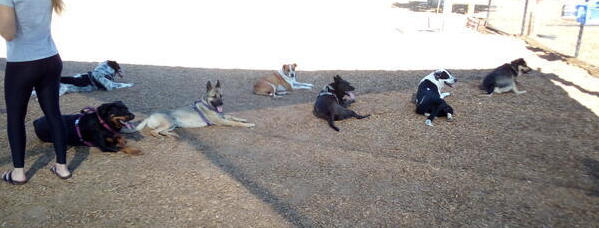Many dog trainers look to throw together some short and attractive sound-bites, then come up with a bunch of reasons why this is both so different and such a terrific approach. Since many people would like to live their dream, why not promise them the dream?
I know, because I know!
I know from dog after dog that I have personally owned and trained that any dog can be the perfect dog if you handle, treat, and train them a certain way. No matter the temperament, no matter the pre-existing problems, any dog can be taught to behave the way you want them to.
Tyler Ohlmann – Rosie Dane Dog Training
Some dogs like and are good at some things, but with other dogs it may be different things. I knew a guy who was a terrific accountant, but all thumbs with tools. And another guy who was a great carpenter, but terrible with numbers. Perhaps they should both go and see Tyler?
And there’s also what the dog likes. I have one dog who likes people, and another who prefers other dogs. One who loves catching a frisbee, but another who doesn’t really care. Why should he only follow my dream when he may have some of this own?
Set Up for Failure
In a lot of trainer circles we call it Fight Park, Louisville dog trainer Tyler Ohlmann told NBC News BETTER. What happens is you get these dogs pent-up in the house driving their owner nuts and owner says, ‘let them run it off,’ and it becomes a powder keg. It only takes one wrong ball or treat or dog and the whole thing blows up.
Ohlmann trained our big dog Cash, and following his advice, we don’t take Cash to dog parks because at most off leash dog parks you find a lot of ill-behaved dogs, he said. I don’t want to put my pup in a risky situation, and luckily we have other outlets for Cash’s exuberance.
Louisville dog trainer Tyler Ohlmann
I’ve been to a few dozen dog parks, and have also visited the local ones several thousands times. And that includes teaching some dogs and bringing dozens of foster dogs there. I’ve rarely seen what those people describe, and their following description of a visit perhaps explains why.

Sadly, there are so very many dog trainers who have likely never met a group of very well socialized dogs (even though they may think so). And even Tyler’s idea of letting a dog get so very bored and frustrated at home and then simply dumping them anywhere at all to let them run it off is so very wrong right from the start. Instead, why not give your dog more exercise and try following some dog park guidance.
Let’s note that Tyler’s alternative simply has the dog running to fetch a ball. That’s a very far cry from the social contact with both other dogs and people which might have enriched his life.
Avoiding instead of learning
If you make it through that gauntlet, your work’s only just begun. It’s not social hour now. You want to keep moving, be walking, said Simon. Any time two dogs are playing for an extended period, there’s an opportunity for one of them to miss social cues and things start to escalate .. [or] one can get tired of playing with the other. So walk around with your dog, let them play with others but then move along, she said. This is where a strong obedience foundation is key, because you have to have a super good recall.
Also monitor things like chasing, said Simon. Is it reciprocal? That’s good play. But if a large group of dogs is chasing [one dog] that’s not good. If trouble starts to brew, try to get the other owners’ attention and make some noises to draw the dogs away. Are you sensing a theme yet? That strong recall comes into play again here.
Dana McMahan, on NBCnews
For sure, during excited play many dogs may miss a few social cues, but so what? If this becomes frequent or bad enough, the other dog may issue a correction to reset things. If the first dog doesn’t respond, that progresses to a minor altercation. That last is most common with young dogs who are in the process of learning social skills, and may only need a time out for a moment or so. And in many of those cases, it’s the socially competent dog they are playing with who calls for the time out.
On managing behavior at a dog park, Dana is a very good example of a lady who really wants to help, but knows so very little about dog behavior and is just making things up as she goes along. If missing just a few social cues resulted in considerable escalation, then one or more dogs needs to learn the skills for managing that. And your trying to move along your dogs too quickly may reduce their impulse control when excited or tired. You are well aware that you cannot possibly watch and guard your dog every second of every day. You know the dog needs to learn social skills to help manage his own safety.

On some kind of super-good recall which will immediately stop your dog from wildly playing with another one at the dog park, that is difficult and so very rare to ever see without considerable training. So much so, that giving that as advice is close to useless.
As for a dog playing chase having to be reciprocal to be good play, that’s purely made up from Data’s own imagination. Some dogs love to start a chase-me, while many more dogs prefer to simply chase them. Sure, some do each at times, but not all. Nor would that type of reciprocity have any real meaning in this context. This is about the same behavior you’d find from young children. This should be about the dogs having fun, and not good play needing them to be reciprocal in some odd fashion.
At bit ago, in the early evenings, we would have 3-4 dogs wildly chasing a laser pointer. And, behind them, about a dozen other dogs just chasing those dogs for the fun of it. Or, a dog cheerleader walks into the part, and immediately organizes a wild chase. When she’s ready to stop, she knows how to signal the entire group of dogs to also stop. If any don’t listen, they are often corrected and taught, and very quickly learn.
The Universal Solution
We draw from various methodologies to create a curriculum that truly produces the ultimate all-around companion animal. Through us you’ll achieve any amount of control you envision and overcome any issue you’re facing.
Rosie Dane Dog Training
He not only insists that a single approach is the ultimate best, but also that it resolves an often serious issue which he never mentions. You see, in the majority of dog behavior issues, the real limiting factors lie with what the owner is both willing and able to do. In some cases the owners lack enough time, but in others they are just not able. I’ve worked with several dogs who, from both genetic temperament and history, need some nearly constant often low-level reassurance and guidance. At the same time, there are many people who are normally fine, but who quickly get very nervous at something unexpected. Pairing those two together, you’ll find that nobody’s in charge when a loose dog runs into her dog’s face.
At the extreme, a few dogs in that situation become so aggressive they must be rehomed. But most cases settle out with some type of compromise, where the owner tries to manage the issue by simply avoiding a few situations they cannot keep control. Sure, if an owner is doing something wrong in walking a dog, you can give them exercises aimed at changing their specific behavior. However, what I’m describing here relates more to the person’s temperament and how they have become used to behaving for many decades. A very fundamental change to make!
Moving back from this extreme we still have limitations in owners that will often prevent his guarantee from becoming real, and this must be taken into account in order to move towards a good working compromise. One that offers benefits and a reasonable future for both the person and the dog.
Nothing he says gives any idea of how he will do this, only that his approach is great and wonderful. All very easy reading for any dog owner, as there’s nothing there to understand. Yet, many people just never notice this.
